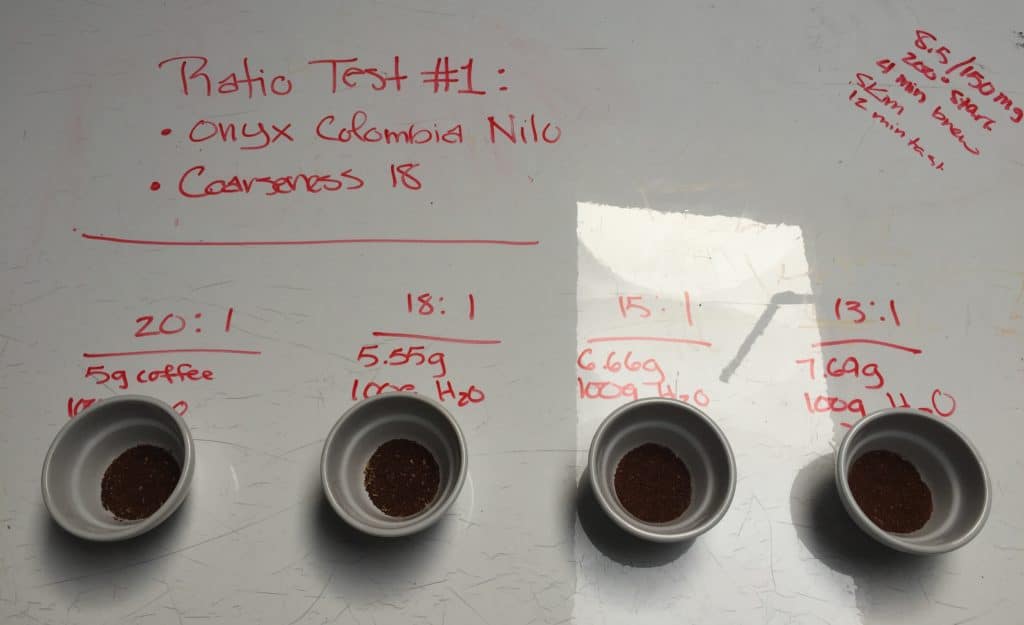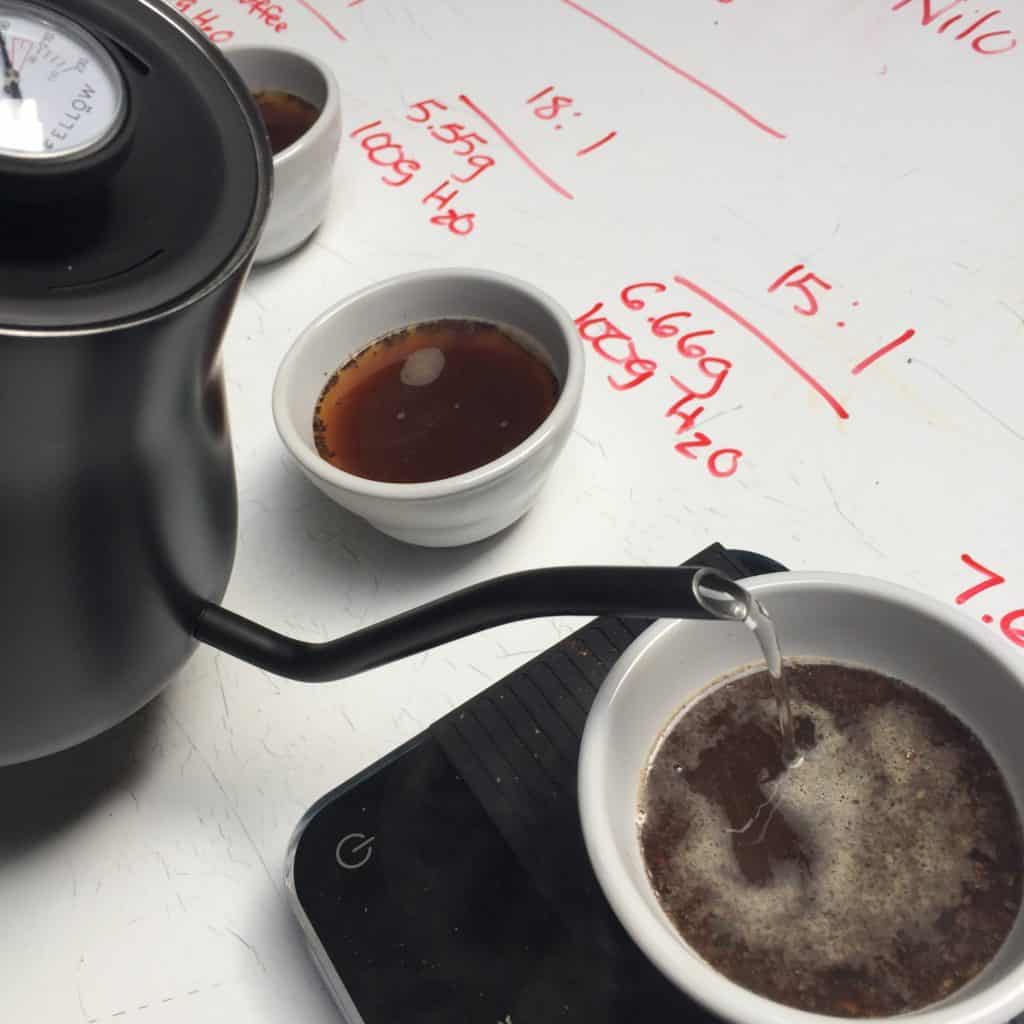Ahh yes, the Golden Ratio. The perfect balance between coffee and water for brewing that perfect cup. One of the biggest barriers to entry we hear when talking to home brewing beginners is knowing the right coffee-to-water ratio. Especially if you’re leaving the world of Keurig (bless your soul) or trying to cut back on purchasing your daily cup of coffee, learning a new brew method and experimenting with the right recipe seems daunting – and even a waste of good coffee.
So let’s break down everything you need to know for the perfect coffee-to-water brew ratio.
BREW RATIO
A brew ratio is simply a guide to help you figure out how much water and coffee you should use for brewing.
Here are a few tips to keep in mind when chatting with coffee nerds about brew ratios:
- Since coffee is 99% water, the larger number in the ratio is always water. We say this because folks will say 18:1 or 1:18 without clarifying which is which, and this can be confusing at first. (Plus, when you get into ratios for espresso, it gets more confusing with more concentrated ratios like 1:3).
- Another key piece of information is remembering that for water, milliliters = grams. So if someone says they are using 20 grams of coffee to 100 milliliters of water, the ratio is 20:100 = 1:5.
- The average cup in America is 8-12 oz, and 1 oz is approximately 30ml. So for an 8-12 oz cup, you’re looking at 240-360 ml.
SCAA, the Specialty Coffee Association of America, has come out with their golden ratio, which is approximately. 1:18. So, therefore they recommend 55 grams of coffee for 1000 ml (grams) of water.
Obviously this golden ratio depends on your brew method, type of coffee, and personal taste preference. There’s a difference between brewing with a drip coffee maker and using a manual pour over or immersion method. Rather than prescribe a specific golden ratio, we want to help you find your own, so we’ve put together a guide and best practices to equip you on this journey.
-

- Heat your water up just past 200°F: You want to pour at 200°F, so it’s good to go a little over.
- Pour 100 grams of water into each cup: Let sit for five minutes.

- After five minutes, keep your timer running but take a spoon and skim the coffee off the top. It should create a layer you’ll need to “crack” off the top. If your coffee is old and has less CO2, the coffee might sink to the bottom.
- After getting most of the coffee out, wait until your clock hits 12 minutes to taste. This gives the coffee time to cool so you can taste the entire flavor profile.
- Mix up each of the cups so you and your fellow tasters don’t know which is which.
Take a spoon and slurp up each coffee. This will help coat your palate to get a better taste. In a notebook, write down your thoughts on each. Is it too weak, too strong? Is the coffee savory, sweet, fruity, bitter? Try to figure out your favorite. After you’re done tasting, unveil which is which to see what’s your golden ratio.
Obviously you’ll want to tweak this ratio depending on your brew method and taste preferences, but this test will help steer you in the right direction for understanding your palate. (Plus it’s fun to do with friends!)
Update: It’s now 2019, three years since we first published our technique to help you find your preferred “Golden Ratio.” In these past three years, we’ve brewed countless cups of coffee and have worked closely with many baristas to grow our coffee knowledge. To aid in your Golden Ratio journey, we’ve gathered a few more tips to hone your coffee-to-water ratios.
Johnny Randolph, Fellow’s former coffee education lead, tailors his coffee-to-water ratio depending on whether he’ll be adding any “extras” to his brew.
If you add milk and sugar, Randolph suggests brewing a densier 1:15 ratio because the body and flavor will hold up better to the added dairy and sweetness.
If you’re drinking your coffee black, Randolph suggests his personal favorite ratio of 1:17. “This ratio gives the different compounds more room. Extra water gives the flavor more space, and it’s easier to notice subtleties in the brew,” Randolph says.
Dylan Siemens, a United States Brewers Cup Champion and lead barista trainer for Onyx Coffee Lab, landed on a 1:16 ratio (22 grams of coffee to 350 ml of water) when brewing with our Stagg [X] Dripper.
Watch Siemens brew this recipe below and then give it a try for yourself:
2023 update!
We now have three certified Q Graders on the Fellow team, the highest achievement in sensory coffee assessment. We asked one of them, our Roaster Partnerships Manager Eric, on his thoughts on the Golden Ratio.
“I've always been a bit thrown off by that term,” says Eric. “To me, a Golden Ratio would be a ratio that brews the best cup of coffee always, despite roast profile, bean density, and water temp. That ratio doesn't exist.”
If you’re looking for general guidance, here’s Eric’s routine: “I typically start with a 1:16 ratio, 205°F water and adjust my grind size based on what I taste in the cup. But there is so much that can change my approach to really dialing in a brew recipe: roast profile, bean density, brew method or device, if I am brewing for more or less people, etc. Also, coffee tastes different from person to person. Experimenting is most important. The brewer should find what tastes the best to them. There is no one right way to brew an excellent cup of coffee.”
Remember, if you find a coffee-to-water ratio you like, that doesn’t mean you’re stuck with it until the end of days. Your “Golden Ratio” can and should be fluid and ever changing as your preferences, taste buds, and brewing methods evolve. We create new custom recipes for coffees all the time, altering the ratio to suit each unique roast. You can explore these recipes in our Brew Talks!


































